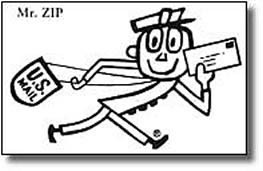Transportation in America's Postal System
By Rickie Longfellow
In early colonial times, letter writers sent their correspondence by friends, merchants and Native Americans via foot or horseback. Most of this correspondence, however, was between the colonists and family members back home in England. In 1633, the first official notice of a postal service in the colonies appeared.
The General Court of Massachusetts designated Richard Fairbanks' tavern in Boston as the official site of mail delivery going to or coming from overseas, a practice long used by England. In 1673, New York's Governor Francis Lovelace set up a monthly horseback post between New York and Boston. Old Boston Post Road is part of today's Route 1. In 1683, William Penn established Pennsylvania's first post office, while in the south private messengers, often slaves, delivered and picked up mail.
Around 1691 Thomas Neale of England received a 21-year grant from the British Crown for a postal service in the colonies. Neale never came to America. This did not prove to be a lucrative move for him-he died in debt after assigning his postal interest over to fellow Englishmen Andrew Hamilton and R. West. In 1707, the British government bought the rights to the North American postal service from West and the widow of Hamilton. John Hamilton, the widow's son, was appointed Deputy Postmaster General of America. In 1761, John Foxcroft of New York served as
By 1800, the Post Office Department had purchased a number of stagecoaches for mail transport. Roads, which became known as post roads, were in better condition because of the mail coaches. Steamboats were used for mail carrying where no roads existed. In the 1830s, trains transported some mail (4.5 miles in 35 minutes) in the East, but Americans were migrating and tracks would take decades to span to newly settled areas. By the 1850s, the population began to flow into the newly acquired Louisiana, Oregon and California territories. Wagon trains transported some of the mail, but were often targets of ambushes and other tragedies. After the 1848 gold rush, the Post Office Department awarded a contract to the Pacific Mail Steamship Company to transport mail to California. During this time some mail was carried by the military between Fort Leavenworth and Santa Fe. The Overland Mail Company stage line of John Butterfield was also awarded a contract. The stages used the 2,800 mile southern route between Tipton, Missouri and San Francisco, California, specified as a 24-day run but often taking months. Californians felt their isolation from lack of regular mail so a better idea was needed.
In 1860, the Pony Express was the brainchild of William H. Russell who had failed repeatedly in getting postal backing to carry mail. His ad in the newspapers seeking riders read: "Wanted. Young, skinny, wiry fellows not over 18. Must be expert riders willing to risk death daily. Orphans preferred." Later the ad was rewritten to be less restrictive. St. Joseph was the starting point for the direct 2,000-mile route to the West. Except for a few settlements and military forts, the route beyond St. Joseph was a vast unknown land inhabited by Natives. Russell, with two partners, built relay stations every 5 to 20 miles, with fresh horses. There was an estimated 150 to 190 relay stations. On an average day a rider could cover 100 miles. Riders were paid from $50 to $100 per month, ranging in age from 11 to the mid-40s, weighing less than 125 pounds. The horses were changed every 10 to 15 miles at the relay stations with riders averaging about 10 miles per hour. The cost of mail-a whopping $5.00 per one-half ounce at first and then later the price was reduced to $1.00 per one-half ounce.
The fastest piece of mail in the history of the Pony Express was President Abraham Lincoln's inaugural address. It was carried to California in 7 days and 17 hours. Although the Pony Express existed for only one and a half years it proved that the Central Route to California was usable year round. On October 24, 1861, the transcontinental telegraph line was completed and the Pony Express, suffering from financial difficulties, was sold to Wells Fargo, and became a legend.
Did your ancestor ride for the Pony Express? To see a list of names of the 228 riders go to: http://www.ponyexpress.org/riders.htm
The first airmail was transported in 1870 by letters in free balloons. It is difficult to think of balloons as a form of transportation, however, on September 23, 1870, more than 500 pounds of mail was sent aloft. It is unknown to date if this mail has reached its destination. In 1911, demonstrations of airplane mail service were made in India, England and the United States.
Although the Wright Brothers successfully flew in 1903, for only 12 minutes, it wasn't until near the end of World War I that planes with motors were used. On May 15, 1918, The United States Post Office inaugurated airmail service from the Polo Grounds, Washington, D.C, thus establishing the Air Mail Service of the U.S. Post Office Department. By this time mail was also being transported via ground as it is today.
Neither snow nor rain nor heat nor gloom of night stays these couriers from the swift completion of their appointed rounds has left a fascinating history of transportation.
Postal Quiz:
- What does RFD mean?
- When did postage stamps become available?
- When were public mailboxes first used?
Answers:
- Rural Free Delivery
- In 1847. Mailers could buy stamps or let the recipient of the letter pay at the other end. Many people refused the letters because they did not have the money to pay, so prepaid mail became mandatory in 1855.
- In 1858, the first mail collection boxes began to appear in larger cities.
 Web Sources:
Web Sources:
- http://www.ponyexpress.org/history.htm
- http://www.usps.com/history/his2.htm#PONY
- http://inventors.about.com/library/inventors/blmailus1.htm
- http://www.airmailpioneers.org/history/Sagahistory.htm
